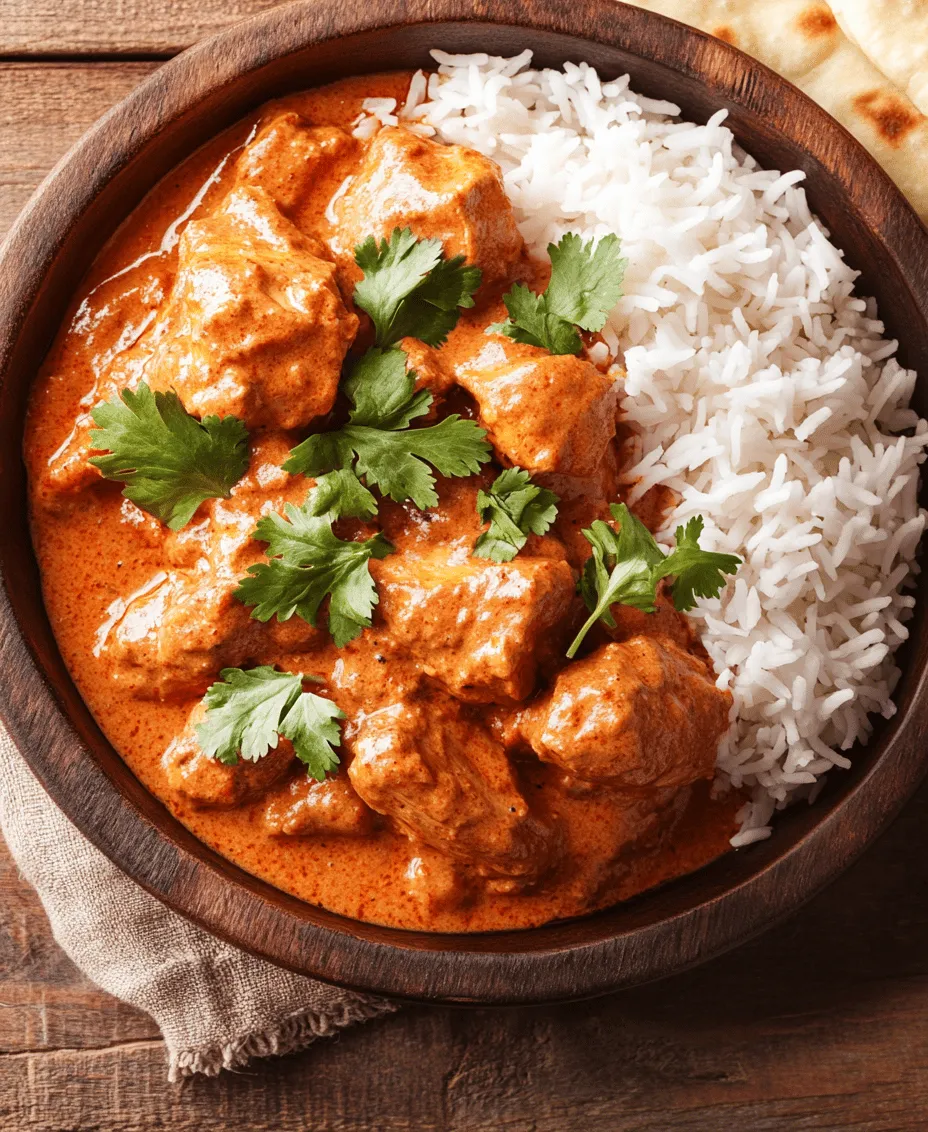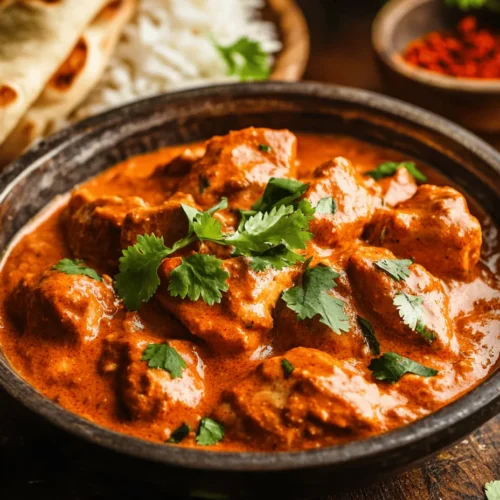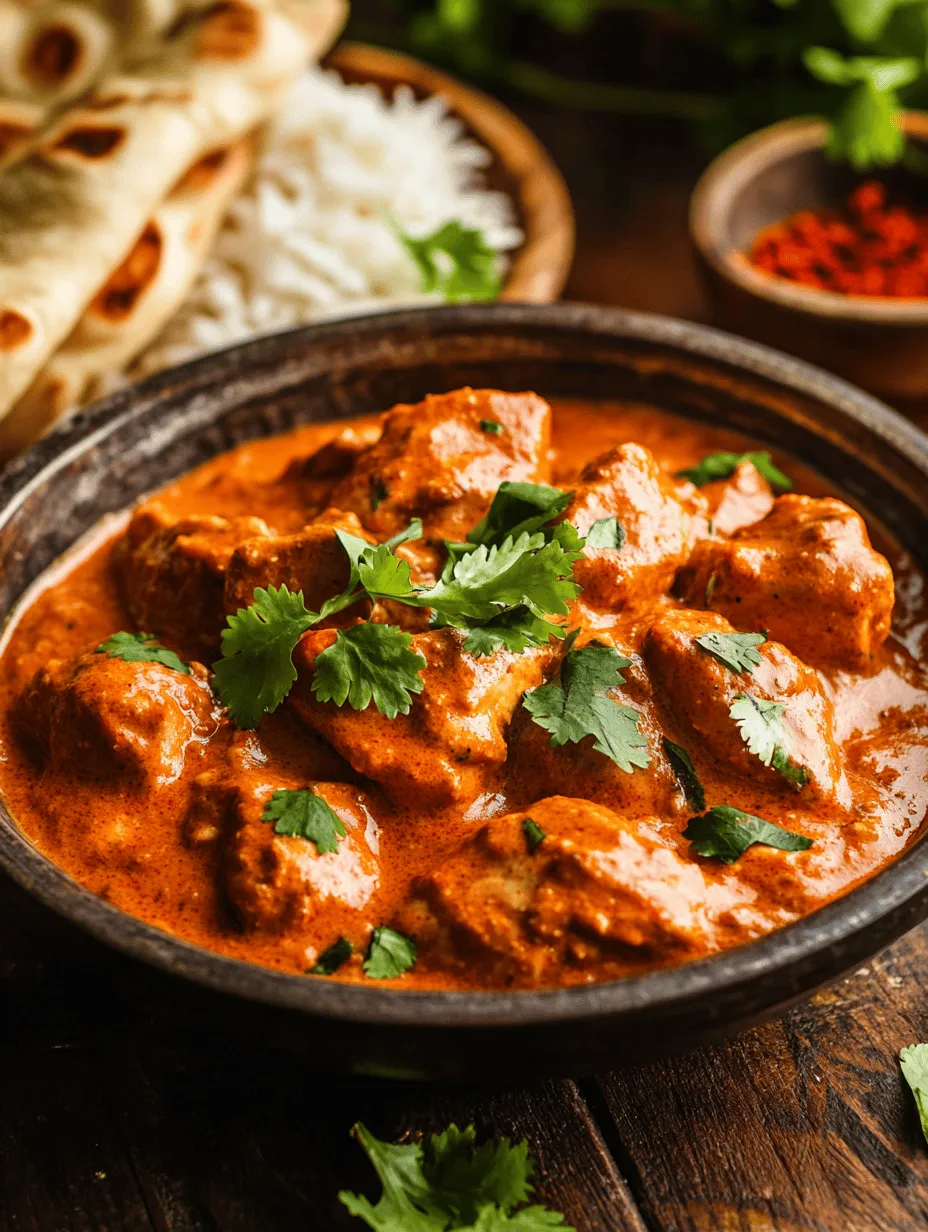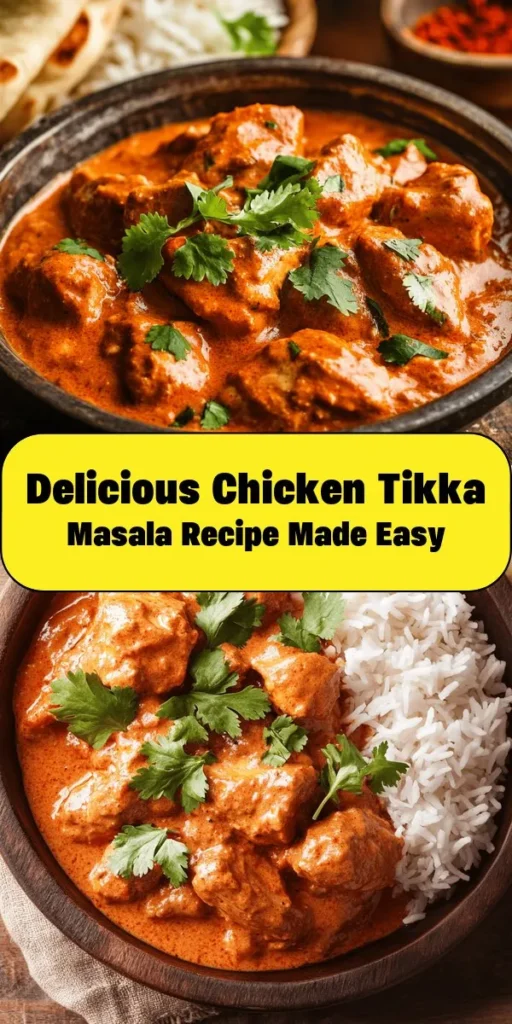Introduction
Chicken Tikka Masala is more than just a dish; it’s a culinary experience that has captured the hearts and palates of millions around the globe. Originating from Indian cuisine, this vibrant and aromatic dish has transcended its geographical roots to become a staple in restaurants and homes in the West. Its intriguing blend of spices, tender chicken, and rich sauce offers a delightful balance of flavors that makes it a favorite among food enthusiasts.
The significance of Chicken Tikka Masala lies not only in its taste but also in its cultural relevance. It embodies the fusion of Indian culinary traditions with Western preferences, resulting in a dish that appeals to a wide audience. While its exact origins are debated, many believe that it was created by Indian chefs in the UK who adapted traditional recipes to suit local tastes, leading to a harmonious blend of flavors that has since become iconic.
When making Chicken Tikka Masala, authenticity is key. The use of fresh, high-quality ingredients is essential in achieving the dish’s signature taste. From the marinated chicken to the rich masala sauce, each component plays a vital role in creating a dish that is both delicious and true to its roots. This recipe will guide you through the steps to create an authentic Chicken Tikka Masala that will impress your family and friends.
Understanding the Essence of Chicken Tikka Masala
To truly appreciate Chicken Tikka Masala, one must delve into its history and evolution. The dish is believed to have originated in the Indian subcontinent, where marinated pieces of chicken—known as “tikka”—are cooked in a tandoor, a traditional clay oven. The chicken is often marinated in a mixture of yogurt and spices, allowing it to absorb rich flavors before being grilled or roasted.
However, the dish as we know it today, with its creamy, spiced tomato sauce, emerged in the UK. It is said to have been developed by Indian chefs serving British customers who desired a milder flavor profile. This cultural fusion means that Chicken Tikka Masala is not only a representation of Indian culinary practices but also a symbol of the global exchange of food traditions.
The marinade is critical in achieving the authentic taste of Chicken Tikka Masala. It not only tenderizes the chicken but also infuses it with a depth of flavor that is characteristic of the dish. The combination of spices, yogurt, and lemon juice creates a perfect balance that sets the foundation for the entire recipe.
Ingredients Breakdown
Chicken Marinade Components
The key to a successful Chicken Tikka Masala starts with the marinade. For this authentic recipe, we recommend using chicken thighs, which provide a juicier and more flavorful result compared to chicken breasts. Here’s a detailed breakdown of the ingredients you’ll need for the marinade:
– Yogurt: This serves as the base of the marinade, providing creaminess and tenderness to the chicken. The acidity in yogurt helps break down the proteins, resulting in a more succulent texture.
– Spices: A blend of spices is essential for the marinade. Common spices include garam masala, cumin, coriander, turmeric, and cayenne pepper. Each spice contributes to the overall flavor profile, adding warmth and complexity to the dish.
– Lemon Juice: The acidity from lemon juice not only enhances the flavor but also aids in marinating, further tenderizing the chicken.
– Garlic and Ginger Paste: Fresh garlic and ginger add a pungent and aromatic quality to the marinade, enhancing the dish’s authenticity.
Detailed Description of Each Marinade Ingredient
– Garam Masala: This quintessential Indian spice blend usually consists of cinnamon, cardamom, cloves, and nutmeg. It lends a warm, aromatic flavor that is crucial for authentic Indian dishes.
– Cumin: Known for its earthy and nutty flavor, cumin adds depth to the marinade.
– Coriander: This spice offers a citrusy note that balances the richness of the dish.
– Turmeric: Recognized for its vibrant yellow color and earthy flavor, turmeric is often used in Indian cooking for both its taste and health benefits.
– Cayenne Pepper: For those who enjoy a bit of heat, cayenne adds a spicy kick that elevates the dish.
Masala Sauce Essentials
The next component of Chicken Tikka Masala is the masala sauce, which is equally important in defining the dish. The sauce is rich and creamy, with a blend of spices that complement the marinated chicken. Here are the essential ingredients for the sauce:
– Onions: Finely chopped onions form the base of the sauce. When sautéed, they develop a sweet flavor that balances the spices.
– Tomatoes: Fresh or canned tomatoes add acidity and richness to the sauce, contributing to its vibrant color and flavor.
– Cream: Heavy cream is what gives Chicken Tikka Masala its signature richness. It adds a luxurious texture and mellows the spices, making the dish more approachable to a wide audience.
Discussion of How Each Ingredient Contributes to the Dish’s Overall Flavor Profile
– Onions: They provide a sweet and savory foundation that enhances the overall flavor of the sauce. When cooked down, they caramelize, adding depth.
– Tomatoes: The acidity from tomatoes balances the richness of the cream, ensuring that the sauce is not overly heavy.
– Cream: The creaminess of the sauce is essential for creating that indulgent mouthfeel that Chicken Tikka Masala is known for. It also helps to meld the spices together, creating a harmonious flavor.
Step-by-Step Guide to Preparing Authentic Chicken Tikka Masala
Marinating the Chicken
To achieve the best results for your Chicken Tikka Masala, proper marination of the chicken is crucial. Follow these detailed instructions to ensure your chicken absorbs all the flavors:
1. Prepare the Chicken: Start with boneless, skinless chicken thighs. Cut them into bite-sized pieces, ensuring they are uniform for even cooking.
2. Make the Marinade: In a large mixing bowl, combine the yogurt, spices (garam masala, cumin, coriander, turmeric, cayenne), lemon juice, and garlic and ginger paste. Mix well until you have a smooth paste.
3. Marinate the Chicken: Add the chicken pieces to the marinade, making sure each piece is thoroughly coated. Cover the bowl with plastic wrap and refrigerate. For the best flavor, marinate for at least 2 hours, but overnight is ideal for maximum tenderness and flavor absorption.
4. Preheat the Grill or Oven: If you’re using a grill, preheat it to medium-high heat. For oven cooking, preheat your broiler.
5. Cook the Chicken: Thread the marinated chicken onto skewers if grilling or place it on a baking sheet lined with foil if broiling. Cook for about 15-20 minutes, turning halfway through, until the chicken is charred and cooked through. The internal temperature should reach 165°F (75°C).
Now that your chicken is beautifully marinated and cooked, you can proceed to the next steps of making the masala sauce. In the following sections, we will explore how to bring all the elements together for a truly authentic Chicken Tikka Masala experience.

Tips on Balancing Spices and Flavors
When it comes to Chicken Tikka Masala, achieving the perfect balance of spices and flavors is essential for an authentic taste. The beauty of this dish lies in its adaptability to personal preferences. Start by tasting your marinade and sauce as you go, adjusting the spices according to your palate. Here are some tips to consider:
– Heat Level: If you prefer a milder dish, reduce the amount of chili powder or use a milder variety. Conversely, for a spicier kick, consider adding fresh green chilies or increasing the chili powder.
– Sweetness: If you find the dish a bit too spicy, a teaspoon of sugar or honey can help balance the heat.
– Tanginess: For extra tang, a squeeze of lemon juice or a dash of vinegar can enhance the flavor profile, especially when added just before serving.
– Seasoning: Always remember to season your marinade and sauce well with salt and pepper. Taste and adjust as necessary throughout the cooking process.
Cooking the Chicken
Cooking the chicken is a crucial step that can significantly impact the final outcome of your Chicken Tikka Masala. You can choose between grilling and baking, each method offering distinct flavors and textures.
Grilling vs. Baking: Pros and Cons
– Grilling: Grilling the marinated chicken adds a smoky depth that enhances the overall flavor of the dish. The high heat from the grill creates a char that adds complexity. However, grilling requires close attention to prevent overcooking, which can dry out the chicken.
– Baking: Baking is a more forgiving method and allows for even cooking without the need for constant monitoring. While it may not provide the same smoky flavor, baking can produce tender chicken pieces when done correctly.
Tips for Ensuring the Chicken Remains Juicy and Well-Cooked
– Marination Time: Allow the chicken to marinate for at least 2 hours, preferably overnight. This not only infuses flavor but also helps in tenderizing the meat.
– Cooking Temperature: If grilling, preheat your grill to a medium-high temperature (about 400°F). For baking, set the oven to 425°F. Both methods should be cooked until the internal temperature reaches 165°F.
– Resting the Chicken: After cooking, let the chicken rest for about 5-10 minutes. This helps retain the juices, ensuring each bite is succulent and flavorful.
Creating the Masala Sauce
The sauce is where the magic happens in Chicken Tikka Masala. A rich, creamy sauce made with tomatoes, cream, and a blend of spices is what makes this dish irresistible.
Step-by-Step Process for Preparing the Sauce
1. Sautéing Onions: Start by heating oil or ghee in a large pan over medium heat. Add finely chopped onions and sauté until they turn golden brown, about 8-10 minutes. This step is crucial; undercooked onions can lead to a raw taste, while overcooked ones can impart bitterness. Aim for a deep golden hue, as this will enhance the sauce’s complexity.
2. Adding Tomatoes: Once the onions are ready, add crushed tomatoes (canned or fresh) to the pan. Cook until the mixture thickens and the oil begins to separate from the tomatoes, about 10-15 minutes. This slow cooking allows the tomatoes to develop a rich flavor.
3. Blooming Spices: As the tomato mixture cooks, add your spices—garam masala, coriander, cumin, turmeric, and chili powder. Cooking the spices in hot oil allows their essential oils to bloom, releasing maximum flavor. Stir continuously for about 2 minutes until fragrant.
4. Incorporating Cream: After the spices have bloomed, lower the heat and stir in heavy cream or coconut milk for a dairy-free option. This addition will create a luscious texture and balance the acidity of the tomatoes.
5. Finishing Touches: Season with salt to taste and simmer for an additional 5-10 minutes, allowing the flavors to meld beautifully.
Combining Chicken and Sauce
Once both the chicken and sauce are ready, it’s time to combine them for the final dish.
Techniques for Integrating the Chicken into the Sauce
– Adding Chicken: Carefully add the grilled or baked chicken pieces to the sauce. Make sure to include any juices that may have accumulated while resting the chicken, as they are packed with flavor.
– Coating the Chicken: Gently stir the mixture to ensure that each piece of chicken is evenly coated with the sauce. Avoid vigorous stirring, as this can break apart the chicken pieces.
Explanation of Simmering for Flavor Melding and Texture Enhancement
After combining, let the chicken simmer in the sauce for about 10 minutes. This step not only allows the chicken to absorb the flavors of the sauce but also thickens the sauce slightly, creating the perfect consistency. The gentle heat will keep the chicken moist while ensuring that the spices penetrate every bite.
Serving Suggestions
Chicken Tikka Masala is best enjoyed with traditional accompaniments that complement its rich flavors.
– Basmati Rice: Serve over a bed of fluffy basmati rice. The rice acts as a perfect vehicle for the sauce and helps to balance the spices.
– Naan or Roti: Freshly baked naan or roti is another excellent option. Use it to scoop up the chicken and sauce, adding a delightful textural contrast.
– Garnishing: For a pop of color and freshness, garnish your Chicken Tikka Masala with chopped cilantro or a sprinkle of garam masala just before serving. A dollop of yogurt or a squeeze of lime can also elevate the dish.
Presentation Tips
– Plating: For an elegant presentation, consider using shallow bowls or large plates. Create a small well in the center of the rice and spoon the Chicken Tikka Masala generously on top.
– Color Contrast: Add vibrant side dishes like a cucumber salad or pickled onions to enhance the visual appeal of the meal.
Nutritional Information
Understanding the nutritional aspects of Chicken Tikka Masala can help you enjoy it as part of a balanced diet.
– Caloric Breakdown: A standard serving of Chicken Tikka Masala (with chicken, sauce, and rice) typically contains around 400-600 calories, depending on the ingredients and portion sizes.
– Protein Content: Chicken is an excellent source of protein, with a single serving providing about 25-30 grams. This makes it a great option for those looking to increase their protein intake.
– Healthy Fats: The dish contains healthy fats from the cream or coconut milk, which can contribute to satiety.
Discussion of Health Benefits of Key Ingredients
– Tomatoes: Rich in vitamins C and K, tomatoes are also a source of antioxidants like lycopene, which is known for its heart-health benefits.
– Spices: The spices used in Chicken Tikka Masala, such as turmeric and cumin, have anti-inflammatory properties and may support digestive health.
– Chicken: As a lean meat, chicken provides essential amino acids and is lower in fat compared to red meats, making it a healthier protein choice.
Conclusion
Chicken Tikka Masala is more than just a dish; it’s a culinary experience that brings together a symphony of flavors and aromas. The joy of preparing this dish at home lies in the process of marinating, cooking, and finally savoring the fruits of your labor. With its rich history and cultural significance, Chicken Tikka Masala has become a beloved staple in many households.
As you master the art of making this dish, don’t hesitate to explore variations and add your personal touches. Whether it’s adjusting the spice levels, experimenting with different proteins, or incorporating seasonal vegetables, the possibilities are endless while maintaining the essence of this traditional recipe. Enjoy the journey of cooking, and may your Chicken Tikka Masala always bring warmth and delight to your table.



